A QSL for NDB PEP on 297 kHz from Prilep, North Macedonia. My 2nd QSL from this country. The beacon is located 1733 kms from my QTH. The Cyrillic text on the email translates as “keep up the good work”!
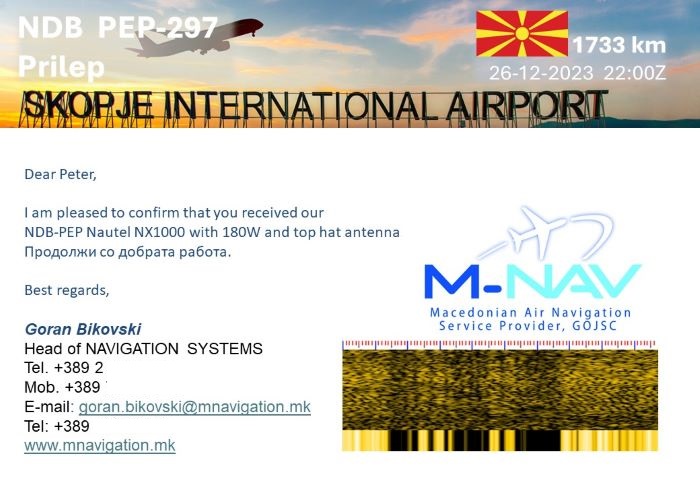
"It's not true I had nothing on, I had the radio on" - Marilyn Monroe
A QSL for NDB PEP on 297 kHz from Prilep, North Macedonia. My 2nd QSL from this country. The beacon is located 1733 kms from my QTH. The Cyrillic text on the email translates as “keep up the good work”!


NDB MAK-360.5 Mackel is an en-route beacon for Brussel Airport. Koen Vanooteghem told me in his QSL for the Oostende NDBs OO, DD and ONO, that historically this beacon is maintained be Skeyes as well. So I sent him a report which was immediately confirmed.
I shared with Koen what I learned about the situation in The Netherlands with NDB NW for Maastricht Airport being the “last man standing” as some satellite navigation details had to be worked out with Belgium. Koen told me that as of January 1st, 2024 all Belgian Airports should have RNAV (satellite navigation) operational. EBAW (Antwerp) has been ready for a while, EBOS (Ostend) is ready since November this year. So the expectation is that Belgian NDBs will be taken off line by end 2024.

The radiobeacons DD, OO and ONO for Oostende Brugge Airport are maintained by Skeyes. Koen Vanooteghem of Skeyes, a HAM operator himself (ON6BVK) was so kind to confirm my reception report. Thanks to Arvid Husdal for the tip.

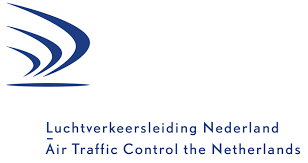
There is only one NDB (nondirectional beacon) left in The Netherlands, and that is NW at Beek, or Maastricht/Aachen Airport. This airport is also “home” of Dutch Air Traffic Control (LVNL), so I sent them an email (info@lvnl.nl) to ask what makes NW so special. I got a friendly reply (thank you!):
LVNL has phased out all NDBs and Locators in recent years, with the exception of the NW beacon. The reason for this is that we now use satellite navigation and these beacons are no longer needed. The navigation procedures have been adjusted accordingly. This was possible in most of the airspace above the Netherlands. Only part of the airspace and route structure in the south of the Netherlands is currently too complex to use satellite navigation. As a result, more time is needed to safely introduce the satellite navigation-based procedures in the border area with Belgium. It is expected that this will be possible sometime in the coming years. After that we can also phase out the NW beacon.
Belgium still has 11 active NDBs, with SLV-386.5 in Spa and ONL-290 in Liège close to Maastricht.

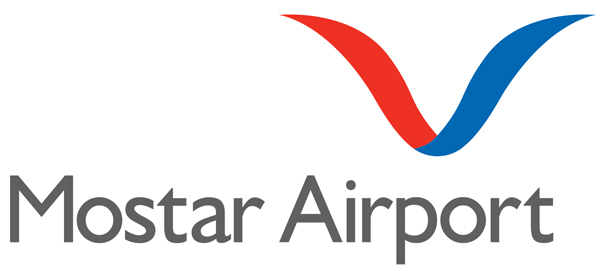
Today I received another email from BHANSA, the Bosnia and Herzegovina Air Navigation Services Agency. This one confirmed all three radio beacons I sent a report for to info@bhansa.gov.ba . So this adds a QSL for NDB DNC-425 Mostar to my collection. A big thank you to Mr. Vlado Juric for this confirmation.
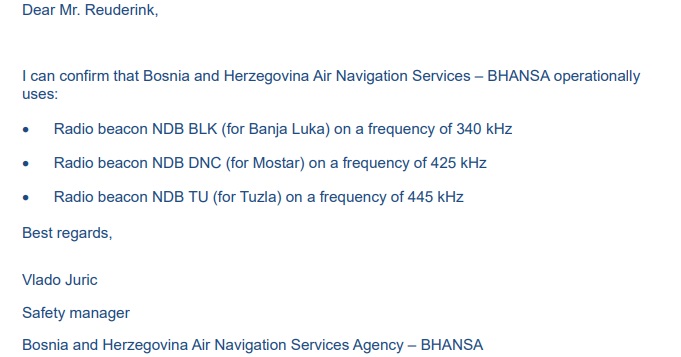
Apparently Mostar Airport is struggling a bit compared to Sarajevo, Banja Luka and Tuzla Airports. In 2012 it was still the 2nd airport after Sarajevo, mainly because of pilgrimage to Medjugorje. Over a million people per year visited this town where Our Lady of Medjugorje appeared to six teens in 1981. I really recommend reading this Wiki about the complexity of religion in an already complex political environment.
During COVID Mostar Ariport lost the two companies carrying out scheduled flights from Mostar Airport, so it is used by seasonal charters only these days. You can find the other QSLs and stories about Bosnia by clicking on these links: BLK-340 and TU-445 .
Yes it is in! An email to QSL NDB PT-295 Skopje. My 190th radio country: North Macedonia! I sent my report to M-NAV, the company responsible for management and control of civilian air navigation in North Macedonia: info@mnavigation.mk .
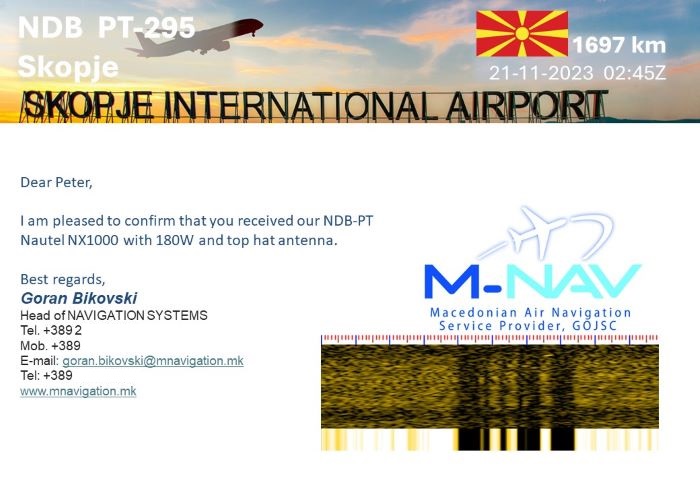
The republic of North Macedonia declared independence from the Yugoslav Federation in 1991. But it took until 1993 before the country was recognized by the United Nations under the name “Former Yugoslavian Republic of Macedonia (FYROM)”. Which turned it into a new “radio country”. I tried to get a QSL from Radio Skopje, a station operating a 1000 (!)kW transmitter on 810 kHz in those days. But where I was never successful prior to independence, I wasn’t succesful after. Once again “NDB DX-ing saved my day”!
The name “Macedonia” was disputed by Greece. They feared that the new republic would lay a claim on the Greek region of Macedonia. The fact that the Vergina Sun featured on the flag of the new republic did not help. Nationalists proposing to depict the “White Tower of Thessaloniki” on the new banknotes aggravated the issue. Fortunately, in 2019 the two countries settled their arguments by signing the Prespa Agreement. The formal name is now Republic of North Macedonia.
A bit awkward maybe is the fact that the EDXC still uses Macedonia to refer to the country with ITU code MKD.
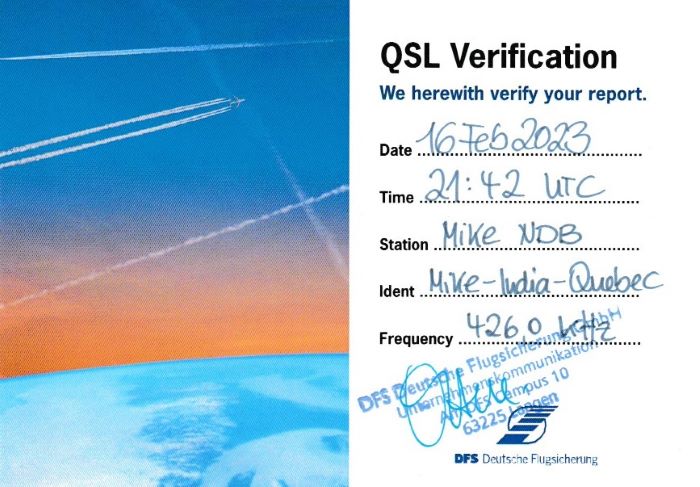
It took 36 weeks, but worth waiting for: a real postcard QSL confirming my reception of NDB MIQ-426 “Mike for Ingolstadt”. I sent my report to DFS (Deutsche Flugsicherung) in Langen, Germany. The beacon is located south of Ingolstadt, and you can actually see it driving on highway A9 between München and Ingolstadt (east of the highway).
Not sure where the “for Ingolstadt” comes from. The beacon is close to Ingolstadt airport. But it is not aligned with the runways and serves as a high and low level enroute navigation beacon according to ourairports.com .
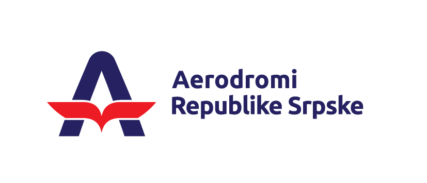
And guess what, a day after my first QSL from Bosnia Herzegovina I received my second. A QSL for NDB BLK-340 Banja Luka. This time the email sent to info@bhansa.gov.ba apparently made it to the right desk. Mr. Stanisic who is head of Air Traffic Control Banja Luka was so kind to send me a confirmation.
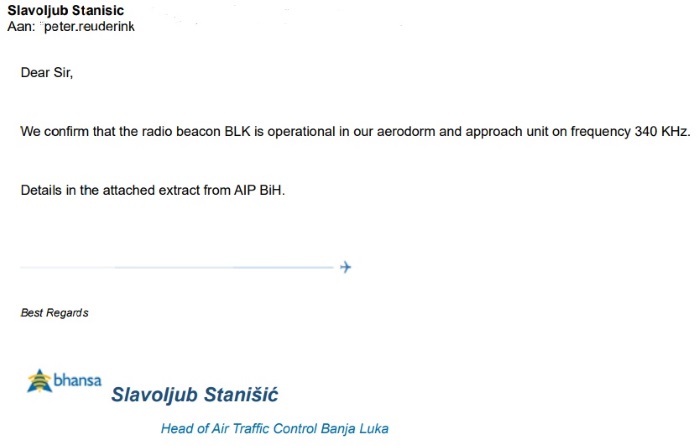
What is a bit confusing is that Banja Luka is situated in Republica Srpska. This translates as Serb Republic, but should not be confused with the Republic of Serbia, which is an independent country (and also still on my “QSL to-do list” by the way). Since December 1995 The Republica Srpska, together with the Federation of Bosnia and Herzegovina form the independent country Bosnia and Herzegovina…. But as the Republica Srpska and the Federation of Bosnia Herzegovina couldn’t agree on who was to own Brčko, that was turned into a third autonomous district in 1999… pretty complicated eh?
To make things even more complicated: the Republica Srpska consists of two parts and according to their current leadership the Republica Srpska should be an independent state. Which would possibly result in a new EDXC radio country as well, and possibly even two (like West and East Malaysia), as they are separated by Brčko …
But as much as this would be nice for us DX-ers, please don’t let them fight another Balkan War over it…
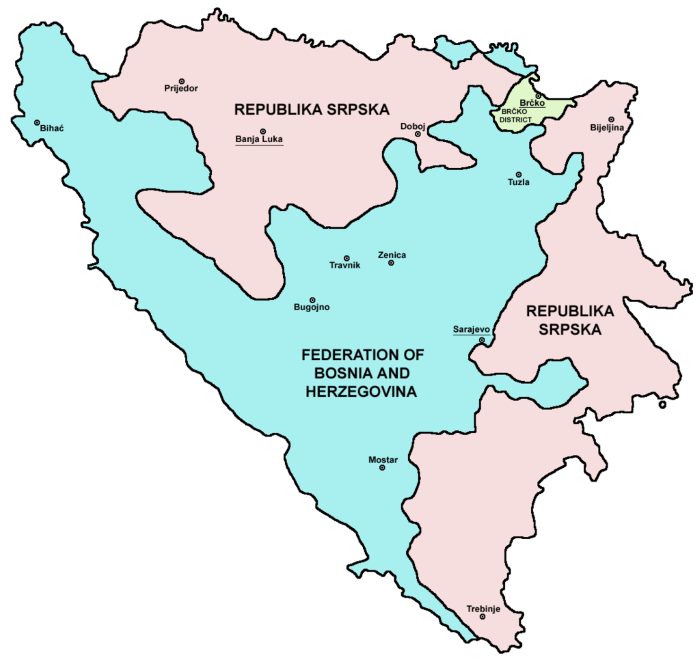

Yesss… a new radio country confirmed: Bosnia Herzegovina. I got an email from Mr. Adnan Becic to QSL NDB TU-455 from Tuzla. If I’ve counted correctly, this is my 189th EDXC radio country. In the 80-ies I was able to receive and QSL Radio Sarajevo. But that was before the Balkan war, and Bosnia Herzegovina was still part of Yugoslavia.
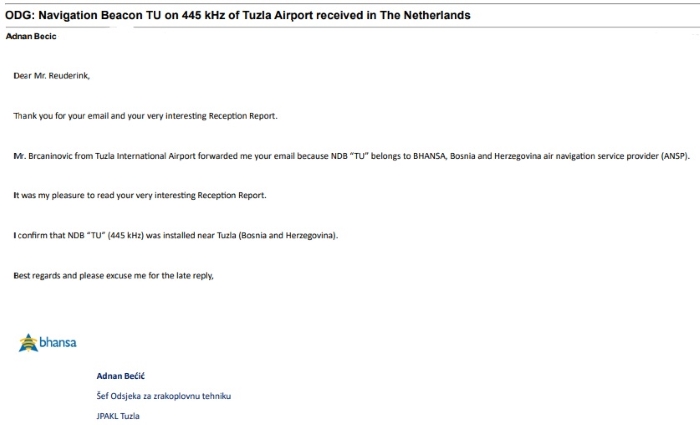
BHANSA is the organization responsible for aeronautical navigation services in Bosnia Herzegovina. I tried sending a report to BHANSA directly about my reception of the Banja Luka Beacon BLK-340. But I only had their corporate email address so it probably never reached the right department. I never got an answer.
So this time I decided to write to Tuzla Airport instead and sent an email to Mr. Brcaninovic, technical manager at Tuzla Airport. He forwarded my message to the BHANSA team (translated from Bosnian language):
Guys.. greetings!
You see if you want to answer this lover of radio signals. I have no idea how (probably the contacts on our website for the technique) but it’s not my responsibility, so I’m forwarding it to you for your attention and possible action. As nice as it is to know that you can hear from Holland 😃
And as you could see, it worked! Thank you Mr. Brcaninovic and Mr. Becic for allowing me to add another country to my list!

Note: the email address was not available in public domain and therefore not published here. You can contact me for further details by submitting a comment.

I was really surprised to pick up a NDB signal from the Azores with considerable signal strength. Below you can see the Pskov recording (I added the morse code for clarity):

The email to QSL NDB FIL-380 near Horta on Faial Island indicates a power of 700W which, in combination with propagation over water, might explain why the signal came through so well.
I sent my report to geral@nav.pt which is the general email address for NAV Portugal, responsible for flight safety in Portugal and the Portugese Islands.
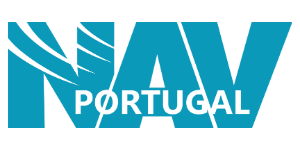
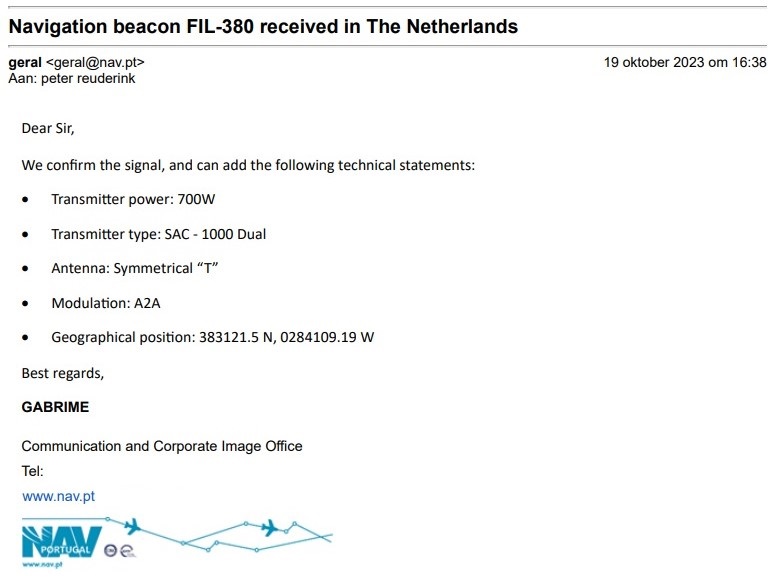
Horta airport is situated on Faial Island. The airport was established in 1971 and offers flights to nearby islands but also to Lisbon, Portugal. On the photo below you see the runway close to the sea and in the distance you see the volcano on nearby Pico island:
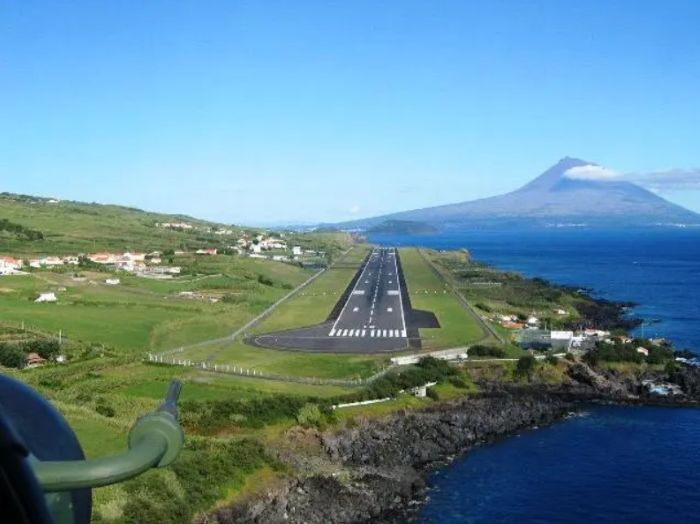
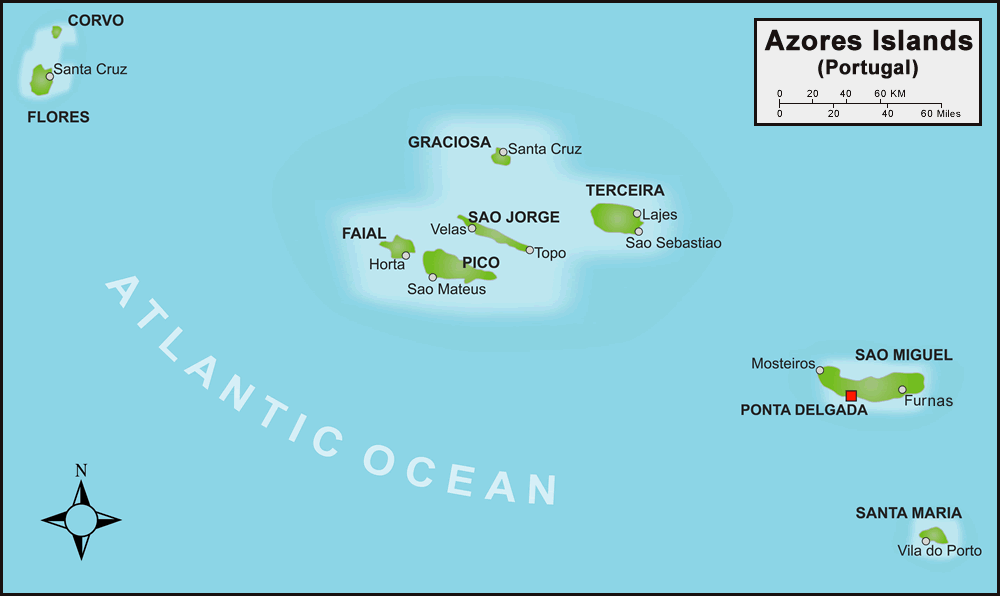
© 2025 Peter's DX Corner
Theme by Anders Noren — Up ↑